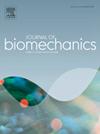Residual force depression in cardiac myofibrils
IF 2.4
3区 医学
Q3 BIOPHYSICS
引用次数: 0
Abstract
History-dependent properties, such as residual force depression (rFD; i.e., the decrease in steady-state isometric force of a muscle, following active shortening, compared to the corresponding force of a purely isometric contraction) have been consistently observed in skeletal muscle. However, the corresponding work on history-dependent properties in cardiac muscle is limited and controversial, and the rFD property specifically remains unexplored. Therefore, the purpose of this study was to examine rFD in cardiac myofibrils.
Myofibrils (n = 10) isolated from the left ventricle of rabbits were held at an average sarcomere length (SL) of 2.2 µm. Myofibrils were then activated, and actively shortened to an average SL of 1.8 µm, held constant at this length until the force reached a steady-state. The myofibrils were then deactivated and allowed to recover for 10 mins. Finally, myofibrils were activated again at an average SL of 1.8 µm, to measure the purely isometric force at this length.
All ten myofibrils exhibited rFD, averaging 23.0 % (± 9.4 %) of the purely isometric reference force. This result suggests that rFD occurs in cardiac muscle within a physiologically relevant range of function, and that similar to skeletal muscle, the molecular mechanisms underlying cardiac rFD originate, at least in part, from the sarcomere.
求助全文
约1分钟内获得全文
求助全文
来源期刊

Journal of biomechanics
生物-工程:生物医学
CiteScore
5.10
自引率
4.20%
发文量
345
审稿时长
1 months
期刊介绍:
The Journal of Biomechanics publishes reports of original and substantial findings using the principles of mechanics to explore biological problems. Analytical, as well as experimental papers may be submitted, and the journal accepts original articles, surveys and perspective articles (usually by Editorial invitation only), book reviews and letters to the Editor. The criteria for acceptance of manuscripts include excellence, novelty, significance, clarity, conciseness and interest to the readership.
Papers published in the journal may cover a wide range of topics in biomechanics, including, but not limited to:
-Fundamental Topics - Biomechanics of the musculoskeletal, cardiovascular, and respiratory systems, mechanics of hard and soft tissues, biofluid mechanics, mechanics of prostheses and implant-tissue interfaces, mechanics of cells.
-Cardiovascular and Respiratory Biomechanics - Mechanics of blood-flow, air-flow, mechanics of the soft tissues, flow-tissue or flow-prosthesis interactions.
-Cell Biomechanics - Biomechanic analyses of cells, membranes and sub-cellular structures; the relationship of the mechanical environment to cell and tissue response.
-Dental Biomechanics - Design and analysis of dental tissues and prostheses, mechanics of chewing.
-Functional Tissue Engineering - The role of biomechanical factors in engineered tissue replacements and regenerative medicine.
-Injury Biomechanics - Mechanics of impact and trauma, dynamics of man-machine interaction.
-Molecular Biomechanics - Mechanical analyses of biomolecules.
-Orthopedic Biomechanics - Mechanics of fracture and fracture fixation, mechanics of implants and implant fixation, mechanics of bones and joints, wear of natural and artificial joints.
-Rehabilitation Biomechanics - Analyses of gait, mechanics of prosthetics and orthotics.
-Sports Biomechanics - Mechanical analyses of sports performance.
 求助内容:
求助内容: 应助结果提醒方式:
应助结果提醒方式:


